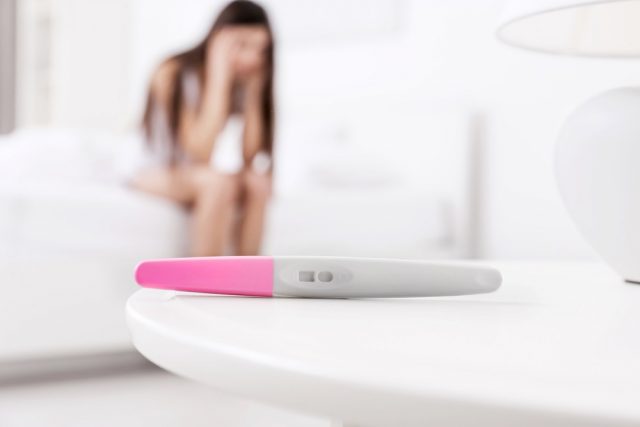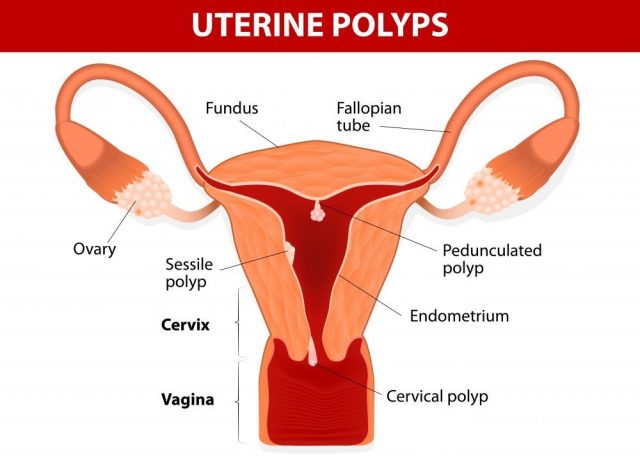Bloody Discharge
It’s normal for women to bleed right after their menstrual cycle. Sometimes, a late discharge occurs towards the end of periods in women which is brown in color. Sometimes, a bloody discharge is also seen between periods which are often called as spotting. There are various kinds of bloody discharges in women and one should monitor these discharges as some of them could be very dangerous.
Bloody Nipple Discharge
A bloody nipple discharge in medical terms is called Intraductal papilloma. A non-cancerous growth sometimes develops inside the ducts of the breasts. These result in abnormal nipple discharge and are often one of the most common reasons for nipple discharge in women. When these growths become inflamed, they result in bloody discharge or sticky discharge from the nipples.

Breast Biopsy: Microscopic image (photomicrograph) of an intraductal papilloma, a benign tumor of the mammary lactiferous ducts (milk ducts). It is typically treated by surgical excision
A discharge that occurs without touching or irritating the breast can be considered abnormal. Many times abnormal discharge can be in yellow, white or green in color. Women who are nursing or who have nursed recently can get some nipple discharge which is considered normal. But all the nipple discharges are not serious and most can be easily treated.
A bloody discharge from nipple is often due to a noncancerous or a benign tumor inside the breast. It generally occurs in a single duct. Most often it resolves on its own but the patient is advised to consult a good doctor and to get herself evaluated with an ultrasound of the nipple and the areola. Often, doctors prescribe a biopsy to confirm the presence of a papilloma if they find a lesion within the milk duct.
One may have breast cancer if:
- There is a lump in the breast
- Only a single breast is affected
- The discharge is bloody
- The discharge is persistent
- Its occurs only in one duct
One must get herself evaluated to check the cause of the underlying condition causing the discharge.
One must get oneself checked if:
- The discharge is consistent even after your next menstrual cycle.
- A spontaneous discharge occurs after menopause in one breast.
Remember to refrain from stimulating the nipples to check for discharge as this worsens the condition.
Bloody Mucus Discharge
Women sometimes experience a bloody or brown colored discharge just after their menstrual cycle. A late discharge is often brown in color. A bloody mucus discharge occurs when the vaginal discharge mixes with pregnancy, ovulation or others.
A vaginal discharge consists of fluid and different cells from the cervix. It is mainly made up of epithelial cells, cervical mucus and bacteria. It is considered vital as it prevents infections in the vagina. The presence of lactobacillus bacterium in the vagina makes it very acidic thereby protecting it from infections.
The following are the possible causes of a bloody vaginal discharge:
- Pregnancy results in bloody mucus discharge which is due to implantation bleeding: When a woman has intercourse during her most fertile days, there are increased chances of getting pregnant. Implantation breeding is the process when the newly formed embryo is transported to the uterus back again and it is implanted or attached to the lining of the uterus. Due to this process, there is some blood loss from the lining of the uterus called the endometrium.
 This blood then mixes with the normal discharge and becomes bloody mucus discharge. This is a clear sign of pregnancy and occurs generally days before or a week before the periods. An early period or spotting during your period days after you have had unprotected sex, then it’s a sign of pregnancy. A pregnancy test done during this bloody vaginal discharge may be negative as the HCG level becomes low during implantation. A bloody period discharge during early pregnancy is quite normal and is not a sign of any problem.
This blood then mixes with the normal discharge and becomes bloody mucus discharge. This is a clear sign of pregnancy and occurs generally days before or a week before the periods. An early period or spotting during your period days after you have had unprotected sex, then it’s a sign of pregnancy. A pregnancy test done during this bloody vaginal discharge may be negative as the HCG level becomes low during implantation. A bloody period discharge during early pregnancy is quite normal and is not a sign of any problem.
Treatment: Vaginal discharge in the early pregnancy is quite normal but if it persists, one should discuss with their doctor.
- Ovulation also results in bloody mucus discharge due to the rupture of the ovarian follicle:
Some women experience vaginal bloody discharge during ovulation. The body starts producing more estrogen as one gets closer to ovulation. During ovulation, the ovarian follicle ruptures resulting in little bleeding. When this blood gets mixed with the normal vaginal discharge it appears as vaginal bloody discharge. The ovary releases the egg during the process of ovulation. This egg matures and results in the rupture of the ovarian follicle.
When a sperm fertilizes this egg, a zygote is formed and the woman is pregnant. The increase in estrogen results in clear and stretchy mucus production which helps to protects the sperm during its transmit from the vagina to the cervix. This mucus also helps to filter the unhealthy sperm and only allow the healthy sperm inside. Cervical mucus helps a woman get pregnant. Ovulation often results in breast pain, increased sexual desires, watery discharge which is stretchy and egg-white in color and abdominal cramps. Leftover menstrual blood also causes the cervical mucus to appear bloody.
Treatment: This is a normal procedure and does not cause much discomfort.
- During sexual intercourse due to cervical trauma or vaginal tear: A rough sexual intercourse sometimes results in cervical trauma or vaginal tear which results in some bleeding. This bleeding mixes with the vaginal discharge and makes it bloody. This condition mostly resolves on its own within a few hours or days. It generally happens when the woman is too dry in the vagina for the process of intercourse.

Endometrial polyp or uterine polyp. Sessile and pedunculated polyps. Polyps consist of dense, fibrous tissue, blood vessels and endometrial epithelium. They are attached by a thin stalk or sessile
A cervical trauma may be a forced sexual intercourse or some sort of injury. This also heals on its own but it may take some time. One should not ignore such symptoms and get oneself checked immediately.
Treatment: Sometimes, a uterine polyp may cause black period blood after intercourse. This should not be ignored and one must consult a doctor and get evaluated.
- Due to bleeding disorders: If you or your family has a history of bleeding disorders then it may affect your body’s healing process and result in bloody mucus discharge. However, this too is not a cause of worry and one should get herself treated immediately by a doctor.
Treatment: Bleeding disorders arise due to hormonal imbalance in the body. Get yourself tested with a good doctor. He may prescribe some hormonal medications.
- Due to vaginal infections like chlamydia, gonorrhea, yeast infection and others:
A foul smelling odor from the vagina is indicative of a vaginal infection. This often results in discharge too with itching and pain during sexual intercourse. This bloody mucus discharge could be due to a vaginal infection.
Vaginal infections can also cause spotting between periods.
Vaginal infections could be:
- Gonorrhea infection: This is a sexually transmitted disease which occurs in the warm and moist areas of the body due to the bacterium Neisseria gonorrhoeae. It spreads from one person to another via unprotected anal, vaginal or oral sex. It also causes bloody smelly discharge.
- Chlamydia infections: This is another sexually transmitted disease which occurs due to bacteria. It mostly affects those who engage in unprotected sex with multiple partners without the use of condom or other ways of unprotected sex.
- Yeast Infection: An overgrowth of the number of yeast organisms which are generally found in small numbers in the vagina result in vaginal yeast infections. It results in irritated skin with thick and clumpy vaginal discharge. The discharge is odorless in a yeast infection.
- Trichomonas infection: This is also a very commonly transmitted sexual disease which is caused due to a protozoan parasite named Trichomonas Vaginalis. It’s not easy to detect the presence of this parasite.
- Pelvic inflammatory disease: When the reproductive organs of a woman such as the ovaries, uterus, and fallopian tubes get infected, it results in a pelvic inflammatory disease. This results in bloody vaginal discharge not period from the vagina. Sometimes the discharge is not bloody.
Treatment: One must get all the symptoms checked by the doctor to find out which vaginal infection is there and get treated accordingly.
- Birth Control Pills also result in bloody mucus discharge due to breakthrough bleeding: A breakthrough bleeding occurs if you take a birth control pill to prevent pregnancy. This often resolves on its own, but if it does not then one needs to consult a doctor. It often is a side-effect of the pills and there is nothing to worry about it.

Treatment: Though bleeding due to birth control pills resolves in some time but if it persists, consult your doctor to change the pill or resort to other forms of contraceptives.
- Endometrial cancer or hyperplasia causes bloody mucus discharge: If a woman has crossed 40 years of age and experiences bloody mucus discharge then it may be due to hyperplasia or endometrial cancer. The uterine endometrium thickens resulting in endometrial hyperplasia. The hormone estrogen in the body has this effect on the endometrium. Bloody discharge after menopause is a bad sign and one should consult a doc immediately as it could lead to cancer.

Treatment: Consult an oncologist or your gynecologist immediately and discuss in detail about your bleeding. Your doctor might prescribe certain tests to rule out the possibility of cancer.
- Stress or eating disorders: Sometimes, extreme stress also results in bloody vaginal discharge not period blood. Strenuous exercises also may cause discharge. Excessive weight loss can also result in abnormal bleeding or discharge.

Treatment: Consult a doctor to get a diet chart which will restore your normal bleeding cycle. Relax from strenuous exercises and discuss your exercise regime with your physical trainer.
- Urethritis: Urethritis is a condition in which the urethra becomes inflamed. Women generally get affected by urethritis because of shorter urethras than men. This results in an increased urge to urinate and pain during urination. It is caused due to bacterial infection. Urethritis can result due to chlamydia or other bacterial infections and also result in abnormal discharge from the vagina which can have streaks of blood.

Treatment: The doctor might take a swab of the urine to test it in the laboratory to diagnose the type of bacteria causing the infection and prescription of antibiotics to treat the condition.
- Genital Herpes: This is a sexually transmitted disease which causes painful blisters that ooze fluid after rupturing. This is caused due to virus which enters the body via the mucous membranes. These enter the body and start to dwell into the cells and start multiplying therein. The discharge can sometimes be streaked with blood resulting in bloody vaginal discharge.

Treatment: Your doctor will prescribe antibiotics and anti-viral drugs to reduce the symptoms and reduce the pain. Good hygiene also needs to be followed in order to treat genital herpes.
Symptoms
A bloody mucus discharge should be checked with and evaluated by a doctor if:
- It gets very bloody and frequent: This could also be the reason for some underlying condition which needs to be treated.
- Longer periods than usual: Usually the period flow is from 3 to 4 days. This differs from woman to woman and the flow also depends. But if the period flow has suddenly become very long then one must get checked.
- One notices black period blood throughout the periods: This could be due to some uterine polyp which could be harmful if left untreated.
- Foul odor from the vagina: This is due to some vaginal infection. Your doctor might prescribe some antibiotics to cure the symptom.
- A mass like substance in the abdomen in felt: This could be a tumor and could be very dangerous is left untreated.
- Severe to moderate but continuous vaginal itching: This is also caused due to some vaginal infection due to bacteria, yeast or other parasitic organisms.
- Pain on having sexual intercourse: Inflammation in the pelvic area could lead to pain during sexual intercourse. It could also be due to infections and certain other conditions.
- Fever and pain in the abdomen: Fever occurs when the body is trying to fight some disease. Consult a doctor to find out the cause of the fever and abdominal pain.
- Heavy bleeding: This also requires consultation from the doctor.
There can be several reasons behind bloody mucus discharge from the vagina. Some causes need immediate attention while some resolve on their own in due course of time.













Jerin Pamela
Sometimes I’m suffering from Bloody Nipple Discharge . After follow your instruction , My problem gone . You are really grate . Thanks:)